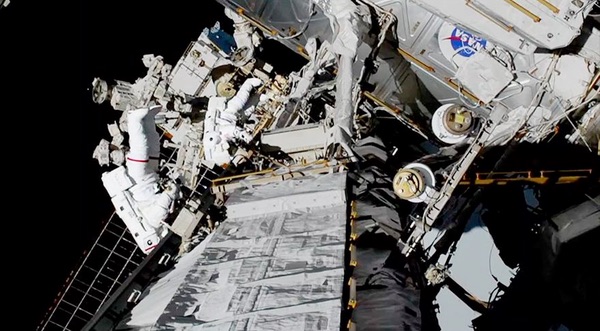Tailoring spacesuitsby Jeff Foust
|
| “We have the right people doing the right job at the right time,” Bridenstine said. |
But early last week, NASA scrambled that schedule of spacewalks. One of three battery charge/discharge units (BCDUs) that had been turned off prior to an October 11 spacewalk to swap batteries failed to turn back on. The remaining three spacewalks to complete the battery replacements would be put on hold, and a new one scheduled for October 18 to replace the BCDU with a spare. The astronauts to carry out that EVA? Koch and Meir.
That decision, agency officials said, was not made with history in mind. “With the content of the EVA and balancing of the overall workload, it made sense for us to make the crew for this spacewalk this week Christina Koch and Jessica Meir,” said Megan McArthur, deputy chief of the NASA astronaut office, in a briefing last week to announce the change in spacewalking plans.
NASA, it seems, tried to have it both ways with the spacewalk. On the one hand, comments by McArthur at others at the agency made the case that this was just a routine spacewalk assignment, a selection made without any thought to its historical significance. Koch and Meir were simply the two astronauts on the station best suited to carry out the spacewalk, based on their training and other issues.
“We have the right people doing the right job at the right time,” NASA administrator Jim Bridenstine said during a briefing with reporters shortly before the spacewalk began. “We are confident that Christina Koch and Jessica Meir will be able to accomplish this mission.”
At the same time, though, NASA was emphasizing the historical aspect of the spacewalk, the first by two women. Besides the media teleconference with the administrator just before it started—something that normally doesn’t happen for a typical spacewalk—NASA invited several members of Congress to an operations center at NASA Headquarters, where they were able to watch at least the opening phases of the spacewalk with agency leadership and other experts.
Among those in attendance was Rep. Grace Meng (D-NY), a member of the commerce, justice, and science (CJS) appropriations subcommittee that funds NASA. At a hearing two days earlier, she grilled Bridenstine about the status of spacesuits, given the attention the topic got in the spring when NASA wasn’t able to conduct an all-woman spacewalk with Koch and McClain.
“What lessons did NASA learn from the cancelled all-female spacewalk at the International Space Station that might help with the research and development of the next-generation spacesuit?” Meng asked.
“I think we had already learned the lessons. I think it made of kind of transparent that spacesuits are very difficult because they’re so large,” he responded. “We need a spacesuit that can go from the one percent to the 99 percent in size.”
NASA made that point a day earlier when it unveiled new spacesuit designs, including the Exploration Extravehicular Mobility Unit (xEMU) intended for moonwalks and the Orion Crew Survival System suit, an updated version of the shuttle-era pressure suits intended for use inside Orion.
“Kristine is wearing a spacesuit that will fit all of our astronauts when we go to the Moon,” Bridenstine said at the spacesuit event, referring to the person wearing the xEMU and its distinctive red, white, and blue color scheme.
For last Friday’s long-awaited all-woman spacewalk, though, agency officials didn’t want to relive the spacesuit sizing issues that led to the cancellation of the earlier spacewalk and the controversy that generated. “People are going to respond the way they respond,” Bridenstine said in the media briefing when asked about the reaction to this spacewalk and the earlier, cancelled one. “We are focused on mission success. We want to make sure that, every time we do a spacewalk, we’re doing it with purpose, to accomplish objectives that are in the best interest of the United States of America.”
“It’s always hard when folks are reacting in a way that you think is not reflecting the data,” McArthur said when asked about her feelings to that public reaction to the cancelled spacewalk. “It’s always hard to anticipate what people’s reactions are going to be. I think we all learned a lot from that situation.”
| “It was hugely wonderful to see two women walking in space together last week,” said Stofan. “But why it took from 1984 until 2019 to see that happen is, frankly, frustrating.” |
At the end of the day, the spacewalk was a success: Koch and Meir replaced the broken BCDU with a spare that powered up as expected, and had time to spare to perform some other work on the station during their more than seven hours outside. They even took time to take a call from President Trump, who congratulated them on their achievement—although he appeared to think this was the first time any woman had done a spacewalk, rather than the first all-female spacewalk. (“We don’t want to take too much credit, because there have been many other female spacewalkers before us,” responded Meir, who became the 15th woman to walk in space on that EVA.)
By Monday, both Bridenstine and Vice President Mike Pence were joking about the event. “A few short days ago—last week, Friday—we saw an unmanned spacewalk,” Bridenstine said at the International Astronautical Congress in Washington. “We had the first all-woman spacewalk.” Pence used the same line a few minutes later in his speech at the conference’s opening ceremony.
“It was hugely wonderful to see two women walking in space together last week,” said Ellen Stofan, director of the National Air and Space Museum, during a panel later the same day at the conference. “But why it took from 1984 until 2019 to see that happen is, frankly, frustrating.”
Note: we are temporarily moderating all comments subcommitted to deal with a surge in spam.
